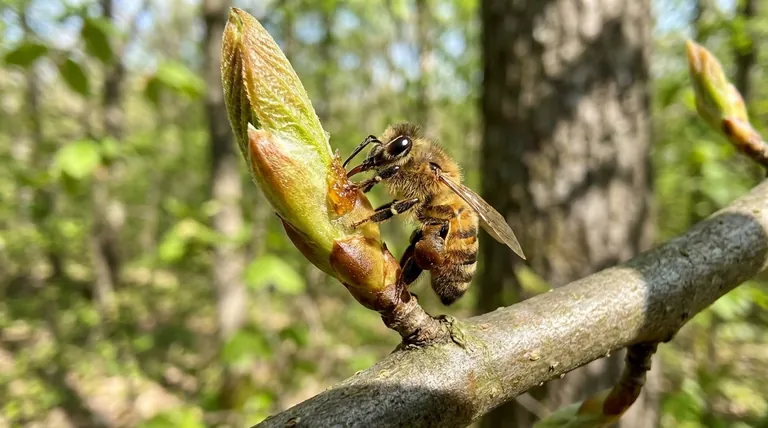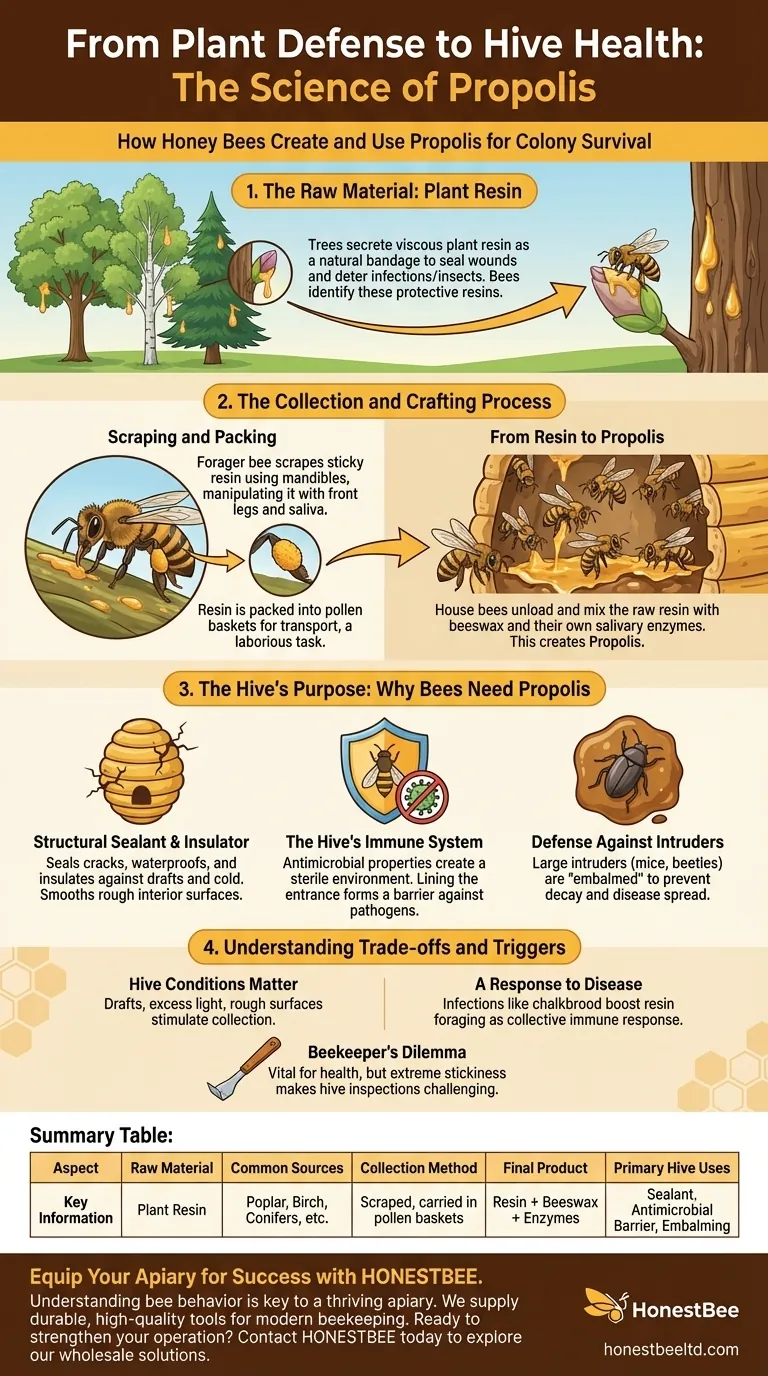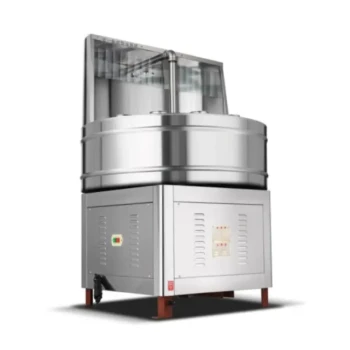To create propolis, honey bees collect a sticky, sap-like substance known as plant resin. Forager bees meticulously scrape this resin from the leaf buds, flower buds, and bark of various trees and plants. They then pack the sticky material into the pollen baskets on their hind legs and transport it back to the hive for processing.
Propolis is not a raw material found in nature, but a carefully crafted hive tool. Bees transform raw plant resins—the plant's own immune defense—into a versatile compound used for structural reinforcement, hive sanitation, and collective disease prevention.

The Raw Material: From Plant Defense to Bee Resource
The creation of propolis begins long before a bee arrives. It starts with the protective mechanisms of plants themselves.
What is Plant Resin?
Plant resin is a thick, viscous substance secreted by trees and other plants to protect themselves. It functions as a natural bandage, sealing wounds in the bark to prevent fungal or bacterial infections and deterring insects.
Bees have learned to harness this natural defense for their own benefit. They actively seek out plants exuding these protective resins.
Which Plants Do Bees Prefer?
The specific sources of resin are entirely dependent on the local environment. However, bees show a preference for certain types of trees.
Common sources include deciduous trees like poplar, birch, cottonwood, alder, and willow, as well as various conifers. The chemical makeup, color, and properties of the final propolis are all dictated by the plants the bees visit.
The Collection and Crafting Process
Collecting resin is a laborious task that requires specialized techniques.
Scraping and Packing
A forager bee uses its mandibles (jaws) to scrape off small bits of the sticky resin from a plant. It then manipulates the material with its front legs, often mixing it with a small amount of saliva.
Finally, the bee transfers the resin to its pollen baskets—the specialized sacs on its hind legs also used for carrying pollen. This is a difficult process, as the material is incredibly sticky.
From Resin to Propolis
Once back at the hive, the forager bee does not deposit the resin itself. Other worker bees assist in unloading the cargo, a process that can take a considerable amount of time.
These house bees then take the raw resin and further work it, mixing it with beeswax and their own salivary enzymes. This final, crafted substance is propolis.
The Hive's Purpose: Why Bees Need Propolis
Propolis is a multi-tool in the hive, essential for structural integrity, hygiene, and defense.
A Structural Sealant and Insulator
Bees use propolis as a caulk to seal small cracks and gaps in the hive, typically any opening smaller than the standard "bee space" of 5/16th of an inch.
This activity waterproofs the hive, reduces drafts, improves insulation for winter, and blocks unwanted light. Bees will also coat rough wooden surfaces to create a smoother, more manageable interior.
The Hive's Immune System
Perhaps its most critical function is sanitation. Propolis has powerful antimicrobial, antifungal, and antibacterial properties.
Bees use it to create a sterile environment. They line the entrance and hive interior with a thin layer of propolis, effectively forcing every bee entering to walk across an antimicrobial mat. This helps prevent the introduction and spread of pathogens.
A Defense Against Intruders
If a pest too large for the bees to remove—such as a mouse or a large beetle—enters the hive and is killed, the bees will use propolis to deal with the threat.
They will completely encase the corpse in propolis. This "embalming" process prevents the carcass from decaying and spreading disease throughout the colony.
Understanding the Trade-offs and Triggers
Propolis production is not constant; it is a direct response to specific needs and environmental cues.
Hive Conditions Matter
Bees are stimulated to collect more resin when they detect problems in the hive. The presence of drafts, excess light from cracks, and rough surfaces will all trigger an increase in propolis collection and application.
A Response to Disease
Research shows that colonies suffering from certain infections, like chalkbrood, will ramp up their resin foraging. This suggests that propolis collection is an active part of the colony's collective immune response, a form of self-medication for the superorganism.
The Beekeeper's Dilemma
For beekeepers, propolis can be both a blessing and a curse. Its role in hive health is invaluable, contributing to a stronger, more resilient colony.
However, its extreme stickiness can make hive components difficult to separate. Beekeepers often find frames, boxes, and covers glued tightly together, making inspections a challenging and disruptive process.
Applying This Knowledge
Understanding the origin and purpose of propolis provides insight into honey bee behavior and colony health.
- If your primary focus is beekeeping: Recognize that rough hive surfaces and small gaps will stimulate propolis production, which strengthens colony health but can make inspections more difficult.
- If your primary focus is understanding bee ecology: View propolis as a prime example of zoopharmacognosy, where animals self-medicate and engineer their environment using natural substances.
- If your primary focus is the use of hive products: Understand that the beneficial properties of propolis are directly linked to the specific resins collected, making its composition highly variable by region and season.
Ultimately, propolis represents the honey bee's remarkable ability to harness the chemistry of the plant world to engineer a safe and healthy home.
Summary Table:
| Aspect | Key Information |
|---|---|
| Raw Material | Plant Resin (from leaf buds, flower buds, bark) |
| Common Sources | Poplar, Birch, Cottonwood, Alder, Willow, Conifers |
| Collection Method | Scraped with mandibles, carried in pollen baskets |
| Final Product | Resin mixed with beeswax & bee enzymes = Propolis |
| Primary Hive Uses | Structural sealant, antimicrobial barrier, embalming intruders |
Equip Your Apiary for Success with HONESTBEE
Understanding the intricate behaviors of honey bees, like propolis collection, is key to managing a thriving apiary. The right equipment can support these natural processes and make hive inspections more manageable.
HONESTBEE supplies commercial apiaries and beekeeping equipment distributors with the durable, high-quality tools needed for modern beekeeping. Our wholesale-focused operations ensure you get reliable equipment that stands up to the challenges of propolis and supports colony health.
Ready to strengthen your beekeeping operation? Let's discuss your needs.
Contact HONESTBEE today to explore our product catalog and wholesale solutions.
Visual Guide

Related Products
- Professional Long-Handled Silicone Honey Scraper for Beekeeping
- Honey Wax Separating Wax Press with Metal Screw Wax Separator Machine
- Stainless Steel Honey Press Wax Press with Tank
- Stainless Steel Pail Perch Bucket Bench
- Retractable Chinese Queen Rearing Grafting Tools Equipment
People Also Ask
- Why is it important to remove detached honeycomb pieces? Prevent Pests, Disease, and Robbing
- What other tools are available for honey uncapping besides knives? Find the Right Tool for Your Apiary's Scale
- What is honey uncapping? The Essential First Step to Harvest Your Honey
- What tools are available for uncapping honey? A Guide to Choosing the Right Tool for Your Operation
- What type of bees are better adapted to certain climatic conditions? Match Bee Strategy to Your Climate for Success



















